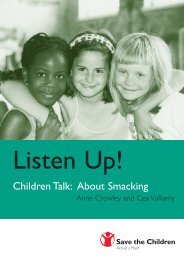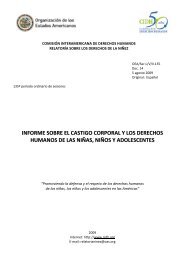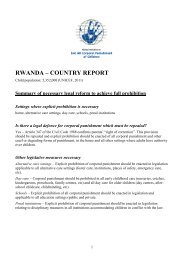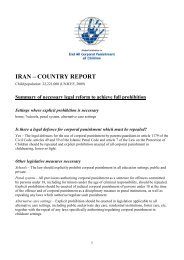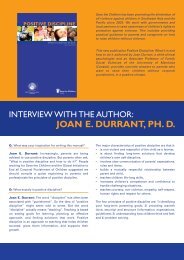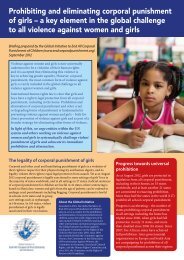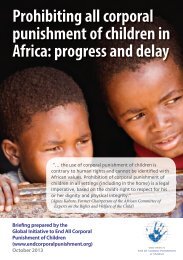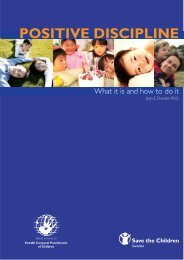Ending corporal punishment of children in Swaziland
Ending corporal punishment of children in Swaziland
Ending corporal punishment of children in Swaziland
- No tags were found...
Create successful ePaper yourself
Turn your PDF publications into a flip-book with our unique Google optimized e-Paper software.
easons for the cont<strong>in</strong>ued use <strong>of</strong> <strong>corporal</strong> <strong>punishment</strong> among adults are l<strong>in</strong>ked to alack <strong>of</strong> understand<strong>in</strong>g <strong>of</strong> the human rights framework protect<strong>in</strong>g <strong>children</strong>, as well as<strong>of</strong> the harmful effects <strong>of</strong> <strong>corporal</strong> <strong>punishment</strong> <strong>of</strong> <strong>children</strong>, among adults. The majority<strong>of</strong> adults have not received any tra<strong>in</strong><strong>in</strong>g on alternatives to <strong>corporal</strong> <strong>punishment</strong> andthey are not equipped with the necessary skills to manage discipl<strong>in</strong>e through nonviolentmeans.In order to ensure that <strong>children</strong> are protected from <strong>corporal</strong> and other forms <strong>of</strong>humiliat<strong>in</strong>g and degrad<strong>in</strong>g <strong>punishment</strong>, new comprehensive legislation on <strong>children</strong>should spell out the need for the government to <strong>in</strong>itiate public education andawareness-rais<strong>in</strong>g to change attitudes to the <strong>corporal</strong> <strong>punishment</strong> <strong>of</strong> <strong>children</strong> andprovide teachers, parents and other care givers with alternative, non-violent ways <strong>of</strong>discipl<strong>in</strong><strong>in</strong>g <strong>children</strong>. Additional f<strong>in</strong>ancial and human resources need to be allocatedto ensure that adults receive tra<strong>in</strong><strong>in</strong>g on <strong>children</strong>’s rights and on alternatives to<strong>corporal</strong> <strong>punishment</strong>. In-depth tra<strong>in</strong><strong>in</strong>g on <strong>children</strong>’s rights and alternatives to<strong>corporal</strong> <strong>punishment</strong> should form part <strong>of</strong> the curricula <strong>of</strong> teacher tra<strong>in</strong><strong>in</strong>g <strong>in</strong>stitutionsas well as tra<strong>in</strong><strong>in</strong>g <strong>in</strong>stitutions for law enforcement <strong>of</strong>ficials and other <strong>of</strong>ficials car<strong>in</strong>gfor <strong>children</strong>. It is also important to reach politicians, parliamentarians and traditionalleaders with <strong>in</strong>formation on why <strong>corporal</strong> <strong>punishment</strong> constitutes a violation <strong>of</strong><strong>children</strong>’s rights.The aim <strong>of</strong> prohibit<strong>in</strong>g <strong>corporal</strong> <strong>punishment</strong> and other forms <strong>of</strong> humiliat<strong>in</strong>g anddegrad<strong>in</strong>g <strong>punishment</strong>, <strong>in</strong>clud<strong>in</strong>g <strong>in</strong> the home, is to send a clear message thatthese forms <strong>of</strong> <strong>punishment</strong> <strong>of</strong> <strong>children</strong> are wrong, and to provide <strong>children</strong> withequal protection under the law. The aim is not to crim<strong>in</strong>alise parents. This is veryseldom <strong>in</strong> the <strong>in</strong>terest <strong>of</strong> the child, because <strong>of</strong> their dependent status, and shouldonly be used as a last resort <strong>in</strong>tervention. In countries where <strong>corporal</strong> <strong>punishment</strong>is outlawed, there have been some discipl<strong>in</strong>ary actions aga<strong>in</strong>st teachers and childcare workers who persist <strong>in</strong> hitt<strong>in</strong>g <strong>children</strong>. In relation to the family home, theselaws are about sett<strong>in</strong>g standards and chang<strong>in</strong>g attitudes, not prosecut<strong>in</strong>g parents ordivid<strong>in</strong>g families.Legislation on its own will not end the use <strong>of</strong> <strong>corporal</strong> <strong>punishment</strong>. To achieve this,legal reform has to go hand-<strong>in</strong>-hand with awareness-rais<strong>in</strong>g and public education tochange attitudes and to promote positive, non-violent forms <strong>of</strong> discipl<strong>in</strong>e. However,legal reform is essential to send a clear message that <strong>corporal</strong> <strong>punishment</strong> is nolonger an acceptable form <strong>of</strong> child-rear<strong>in</strong>g. This is a key issue on which politiciansneed to lead, and not follow, public op<strong>in</strong>ion. Research shows that public attitudeschange rapidly when legal change is accompanied by awareness-rais<strong>in</strong>g andeducation. As long as the law allows <strong>corporal</strong> <strong>punishment</strong>, it will be used as adefence to cont<strong>in</strong>ue this practice that <strong>in</strong>fr<strong>in</strong>ges on <strong>children</strong>’s rights.21



